TLDR Summary:
As the leader of the Walmart Identity Product Suite revamp, I focused on streamlining access issues, particularly by enhancing OTP awareness. We made email OTP widely available and introduced a phone collection initiative for verifying numbers, laying the groundwork for phone OTP. We reduced login errors by 35% and significantly elevated customer trust and engagement.
Introduction:
In digital commerce, Walmart’s Identity Product Suite is pivotal as the gatekeeper for millions of customers navigating the retail giant’s online ecosystem. Its significance lies in facilitating seamless interactions and fortifying security measures to protect user data. Customers who sign in are 2.2 times more likely to be return shoppers and spend around $320 more yearly than online guest shoppers. They’re also more likely to explore other Walmart services like W+, Health and Wellness, and Financial Services. which could lead to the potential benefits of a GMV increase of 0.8% – 1.7%.
My Role:
As the Principal Product Designer for Walmart’s Identity Product Suite, I spearheaded the strategic design and execution of a sweeping redesign focused on enhancing user experience and security by reducing friction around existing customers not remembering their account credentials and customer input errors. My responsibilities included:
- Strategic Design Leadership: Crafting and implementing design strategies that align with Walmart’s business goals and customer needs.
- Design System Management: Developing and maintaining robust design systems to ensure consistency and scalability across the digital ecosystem.
- Cross-functional Collaboration: Working closely with engineering and product management to ensure seamless design integration with product development and testing.
- Innovation and Implementation: Adopting and overseeing recent technological and security advancements, trends, and methodologies to improve the product design lifecycle.
- Usability and Accessibility Standards: Ensuring that all design outputs meet high standards of usability and accessibility, catering to a diverse user base.
The Challenge:
Our journey begins with recognizing the hurdles users face in their online interactions. Customers need help with the cumbersome nature of password management, leading to frustration and impediments in their shopping experiences. High errors were tied to existing customers trying to create accounts with existing credentials. Additionally, the disparity in success rates between traditional password-based logins and those using verified phone numbers highlighted the pressing need for a more user-friendly authentication process. The suite also grappled with the threat of malicious activities, such as fake account creation, which undermined customer trust and security.
SCENARIO: wrong CRedentials at sign-in
Customers may face issues while signing in, particularly when they mistakenly enter the wrong email address. In such cases, they might overlook this error and concentrate on entering their password, which leads them to unnecessarily reset the password without solving the underlying issue.
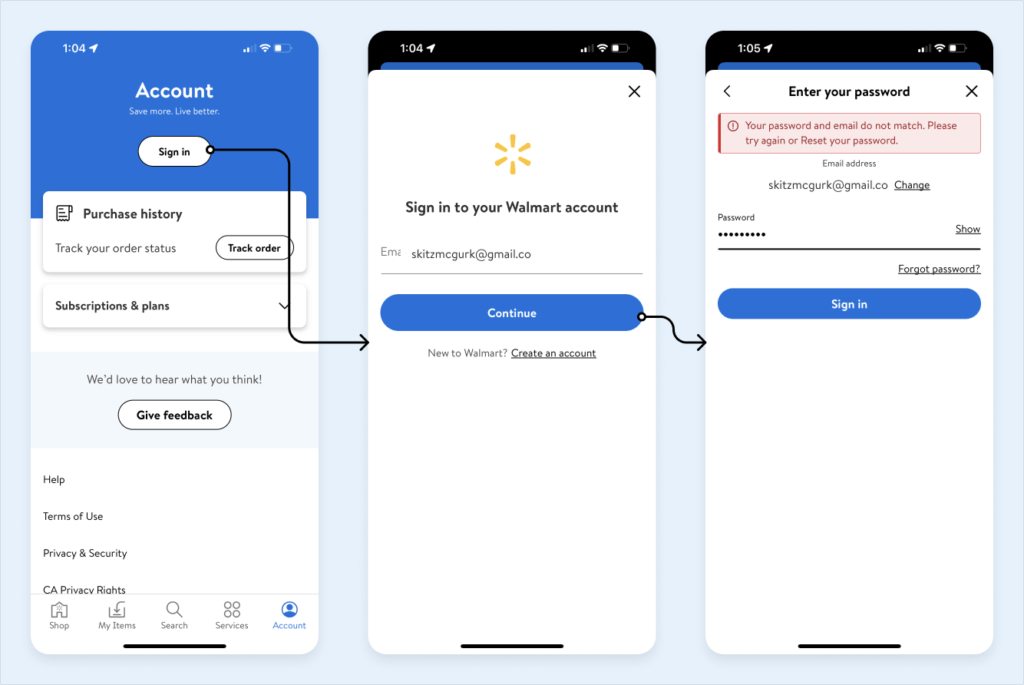
SCENARIO: already has an account
If customers try to create an account with an email that is already linked to an existing account, they will face an obstacle and will have to go back to the previous screen.
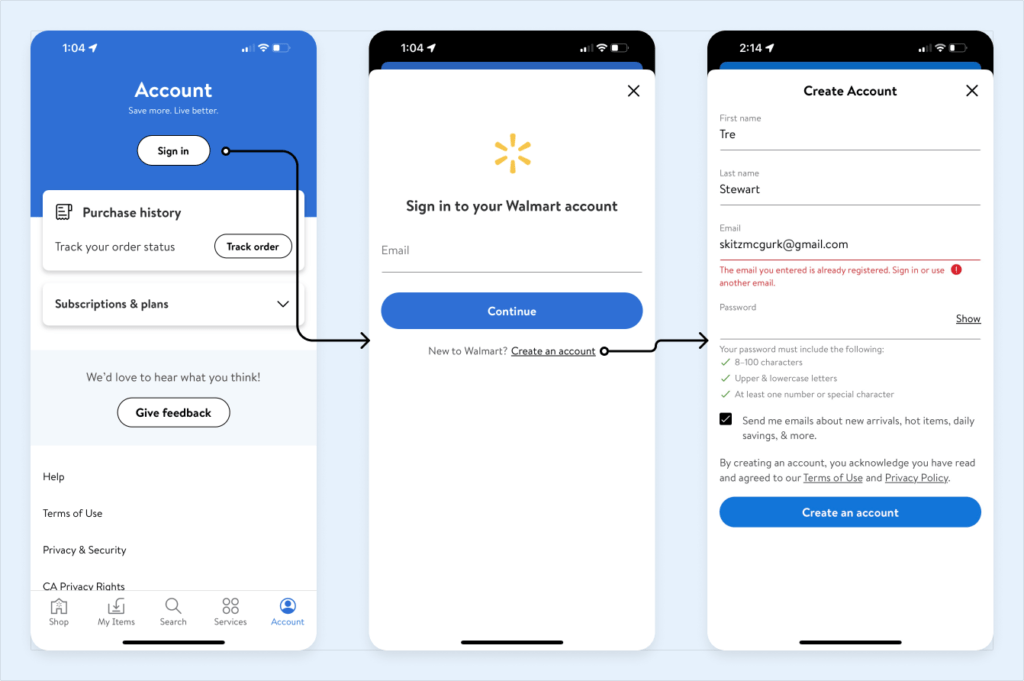
Key Pain Points
The sign-up page has a 60% error rate due to customers not remembering if they have an account or associated password.
Intentionally vague error messages for unrecognized email IDs cause frustration and potentially result in abandoned shopping experiences.
VALUE OF THE PROJECT
FOR CustomerS
- Reduced login failures and frustration associated with password memorization.
- Improved perception of security and trust in Walmart’s digital platforms.
FOR WALMART
- Increased user engagement and retention through enhanced login experiences.
- Strengthened security measures and reduced potential for unauthorized access.
The Journey Begins
Armed with a deep understanding of these challenges, we embarked on a journey to revamp Walmart’s Identity Product Suite. Our first step was to review the findings from our research team and the customer’s voice through feedback user research, encompassing interviews, surveys, and usability tests.
Defining the Solution
How might we improve authentication methods to ensure both security and convenience for customers?
How Might We statement
Informed by the insights gleaned from our research, we outlined a bold vision for the future of Walmart’s identity experience. Central to this vision was a unified entry point—a seamless portal where users could effortlessly navigate between sign-in, account creation, and recovery, guided by personalized pathways tailored to their verification status. Additionally, we aimed to increase the use of one-time password (OTP) authentications to alleviate password fatigue and enhance security.
Phase 1: Unified Login:
Customers often struggle with password fatigue or forgetting their passwords, leading to frustration and abandoned shopping journeys.
Customer pain point
Hypothesis & Solution
Implementing a unified entry point and dynamic routing based on email ID verification streamlines the sign-in and sign-up process. By merging these flows, the system determines the appropriate customer journey, eliminating the friction of remembering previous registrations and reducing errors.
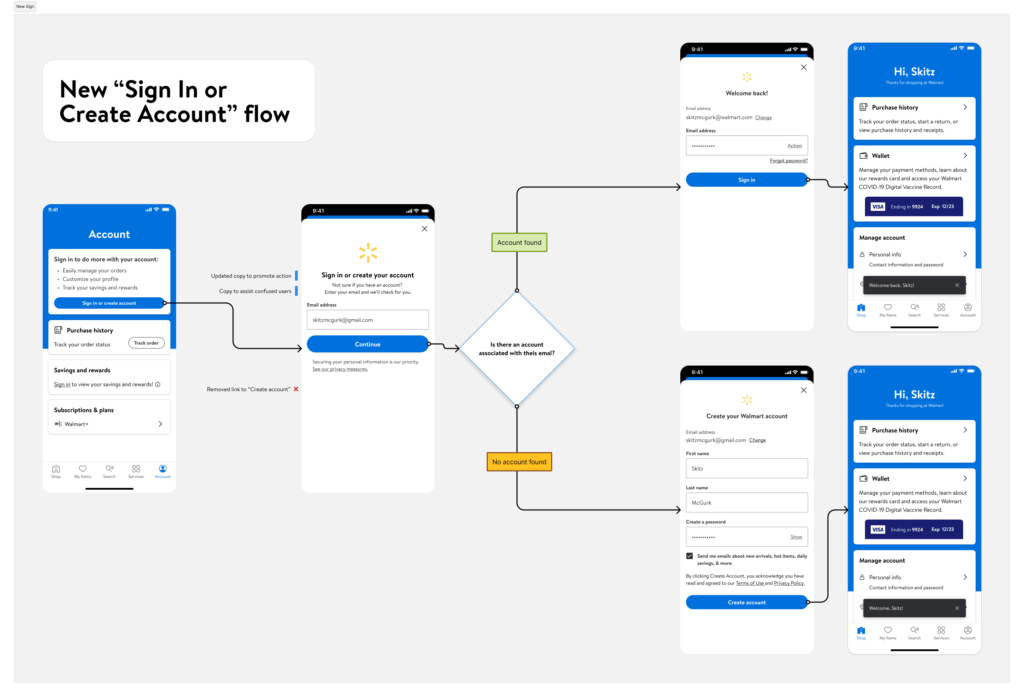
Key Features
Unified entry point for email address input.
Dynamic routing to sign in or create an account based on email ID verification.
Impact:
- Achieved a 35% increase in sign-up volume.
- Reduced sign-in error rate by 35%.
- Decreased sign-up error rate by 20%.
Phase 2: Phone Collection
Customers often struggle with password fatigue or forgetting their passwords, leading to frustration and abandoned shopping journeys.
Customer pain point
Hypothesis & Solution
Given that customers using verified phone numbers demonstrate higher login success rates than those relying solely on passwords, we propose implementing a comprehensive strategy to collect and verify customer phone numbers. This approach enables various use cases such as OTP step-up challenges, sign-in with OTP, security alerts (SMS notifications), and prefilling phone numbers for order delivery/pick-up.
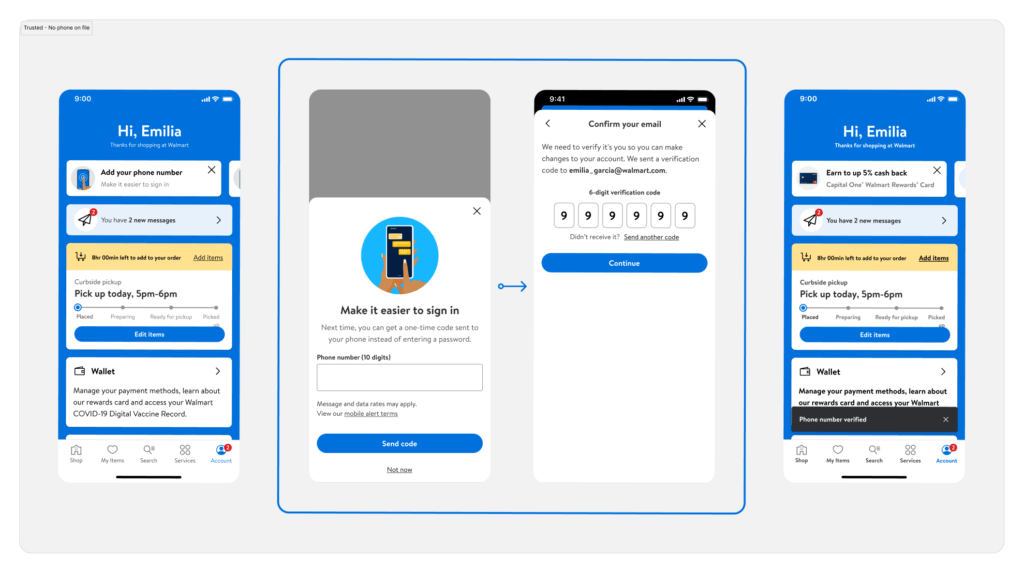
Key Metrics for Success
Increase in the number of confirmed and verified phone numbers on file.
Key performance indicators:
- Percentage of customers with confirmed and verified phone numbers on file.
- Sign-in success rate for customers using phone OTP authentication.
- An overall increase in sign-in conversion rate.
Impact:
- Phone OTP authentication maintained a high success rate of 93.77%, enhancing security.
- Over 60% increase (~11 million) in verified phone numbers on file, further strengthening security measures and expanding user authentication options.
PHASE 3: INCREASING OTP AVAILABILITY:
Most customers have two options to sign-in: either entering a password or verifying OTP sent to the phone. However, password fatigue and forgotten passwords are common issues, leading to frustration and abandoned shopping journeys.
Customer pain point
Hypothesis & Solution
Allowing password-based users to use email OTP for sign-in without the need for a verified phone will simplify the process, leading to higher sign-in success rates and increased authentication rates.
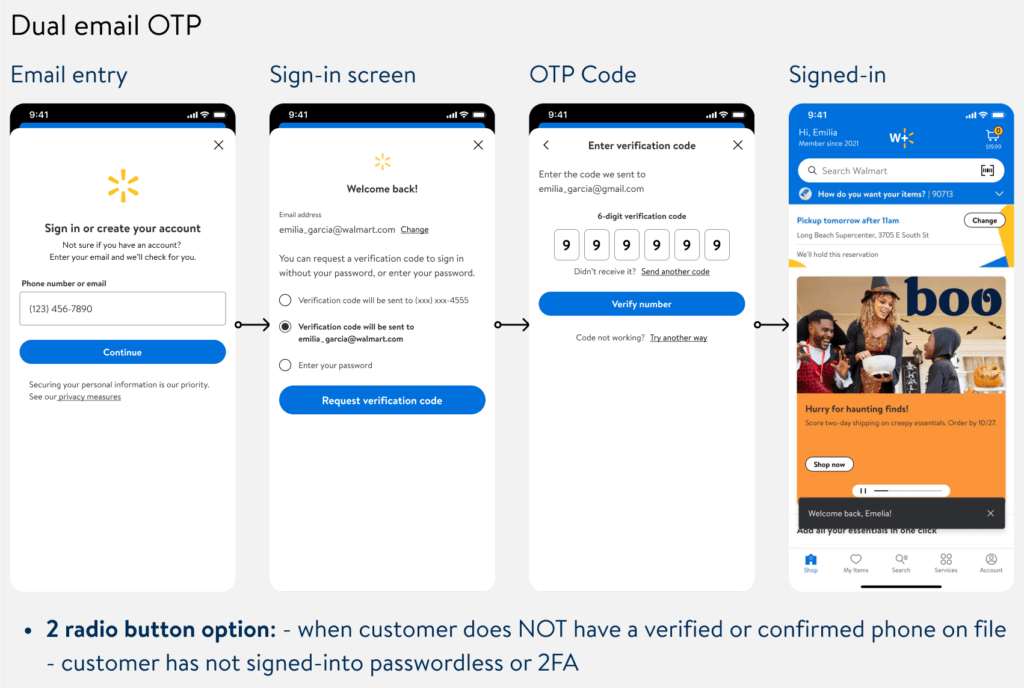
Key Metrics for Success
Improvement in sign-in success rates leading to an increase in the authentication rate.
Key performance indicators:
- Percentage of successful sign-ins using email OTP
- Track the overall increase in the number of users authenticating their accounts after successful sign-ins with email OTP.
- Evaluate the percentage of password-only customers who opt for email OTP sign-in after its introduction as an alternative authentication method.
The Impact Unfolds:
As our redesigned Identity Product Suite took shape, its impact reverberated across Walmart’s digital landscape. Sign-up volumes surged, driven by a newfound sense of simplicity and clarity in the user experience. Sign-in errors dwindled, replaced by fluid authentication processes that instilled confidence and trust in our users. Importantly, user feedback flooded in—testimonials expressing gratitude for a design that felt intuitive, responsive, and empowering. The number of verified phone numbers on file increased from 11 million to 52 million.
Conclusion:
In the dynamic landscape of digital commerce, the importance of identity cannot be overstated. It is the linchpin of user engagement and the bedrock of trust between brands and consumers. In redefining Walmart’s Identity Product Suite, we haven’t simply redesigned a set of features—we’ve reimagined the essence of user experience, weaving together simplicity, security, and sophistication to create a seamless journey for all who interact with our digital platform. As we look toward the future, our mission remains clear: to shape the evolution of commerce by elevating the digital identity experience and enriching the lives of millions.

